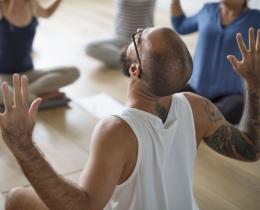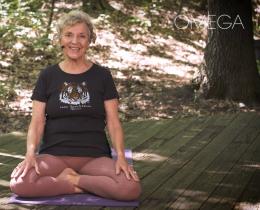When adapted to meet the needs, concerns, and values of military personnel and veterans, yoga can be an exceptional resource for rebuilding the capacity to maintain emotional equilibrium.
Help Students to Find Their Edge
Encourage veterans to “find their edge” safely by balancing force and ease.
Many veterans have internalized the well-known adage of “no pain, no gain.” Often, they may want to push hard to “achieve” poses, or even become competitive with each other in performing more difficult ones. These behaviors focus on external goals rather than internal awareness and can easily lead to injury.
As a yoga teacher, you can remind students that there is no end goal except their own self-awareness and personal health, which only they can fully determine. You can encourage students to notice when they are developing stress in the body and/or mind as they hold a pose, and teach skills to help them release it. You can also help veterans learn to titrate force with language like: “Come up to your edge of discomfort in this pose, and then back off to the point of no strain, or pain.”
Finding that “edge” can be a skill that takes time to learn. With ongoing reminders, refocusing, and reassurance, students can learn to tolerate an appropriate level of discomfort, which enables them to engage with their yoga practice more deeply, while maintaining physical and psycho-emotional safety.
Develop Proprioception & Interoception
Teach yoga in ways that help develop greater internal awareness of the physical location of the body, as well as feelings and sensations within it.
The practice of yoga naturally increases proprioceptive skills (i.e., the ability to know where the body is in space through internal awareness). As a teacher you can best support students in developing proprioceptive awareness by employing a friendly, curious, nonjudgmental approach. Use clear, concise language that directs the students to notice how their body feels—before and after a pose, on the right versus left side of the body, and so on—to help them build proprioceptive capacity. You can also help students develop a set of sensory memories through repeating short sequences of synchronized movement and breath.
Interoception is similar to proprioception in that both involve internal awareness. In this case, the focus is on feeling, sensation, and emotion, rather than physical movement and location. Neuroscience has shown that engaging the internally focused state of awareness involves a different part of the brain than our usual, everyday, externally focused state. Learning to work with these different parts of the brain is important because it offers the opportunity to work with feelings directly, rather than having to process everything through concepts and language at all times.
Because military members have been trained to maintain tight emotional control, a yoga class that fosters relaxation and acknowledgment of personal feelings may be initially uncomfortable for them. You might want to inform students that their experience of yoga may change from day to day, and even minute to minute. Class one day may feel great. The next day, the student might be tired, off-balance, or challenged by sensations and feelings.
You can guide your students to accept the different ways that they feel from day to day “on the mat,” and explain how this can translate to being able to meet the changing circumstances of life “off the mat” with increasing presence and ease. As much as possible, try to attune to students’ psycho-emotional states and adjust your teaching to support them in exploring yoga at their own pace.
Facilitate Deep Relaxation
Make time for deep relaxation at the end of every class.
It is important to end a yoga session with a period of relaxation. It is also important to give students a choice about how they relax. The traditional relaxation posture practiced at the end of a yoga class—savasana—involves lying on the back on the floor. Some people feel overly vulnerable in this position. Give students the option to relax in another position, like lying on their stomach or sitting on a chair.
In civilian classes it’s not a standard practice to give students permission to fall asleep during relaxation. But with military personnel and veterans, you will want to let them know this is okay. Many have nervous systems that are hyper-aroused and the ability to relax is key to self-regulation.
If students fall asleep in class and start snoring, simply direct other students to incorporate any sounds in the room into their relaxation. Before relaxation begins, you may suggest that those who know they snore make adjustments, like elevating their torso, as a courtesy to their fellow classmates.
Use guided imagery and body scans to support a deep relaxation response, but keep the imagery general. Avoid invoking specific settings—for example, a beach or a forest—as they may evoke disturbing memories. You may wish to use a body scan that includes tensing and releasing different parts of the body, moving progressively from feet to crown.
While relaxation is important, keep the session short. Extended periods of silence are not recommended for beginners and may be especially discomforting or triggering for veterans with PTSD.
Link Self-Regulation to Personal Empowerment
Teach veterans to utilize yoga-based skills as resources for self-regulation and personal empowerment in everyday life.
By developing a repertoire of yoga-based skills that includes physical poses, breath work, proprioception, interoception, and relaxation, students gradually learn to regulate their own nervous systems, energy levels, and mental and emotional states more effectively.
With time, the development of such self-regulatory skills enables military personnel and veterans to experience a greater range of choices in everyday life. Rather than simply reacting to whatever thoughts and feelings come up in a given situation—or, conversely, forcibly overwriting them to conform to a preset behavior—they gain the ability to notice, process, and work with them intentionally.
As a teacher, you may wish to gradually introduce students to the idea of self-regulation as a means of increasing one’s capacity to make choices, and, consequently, a resource for personal empowerment.
As with any other yogic practice you are teaching, look for ways to deepen these skills in your own life in order to teach them more effectively to others.









